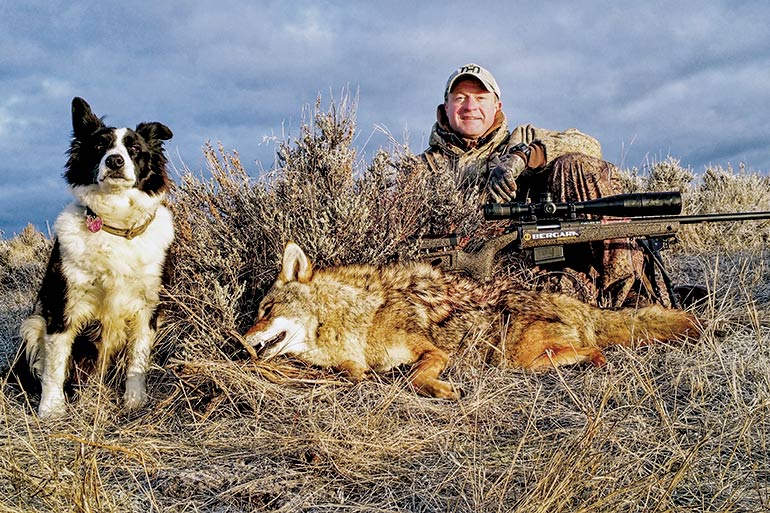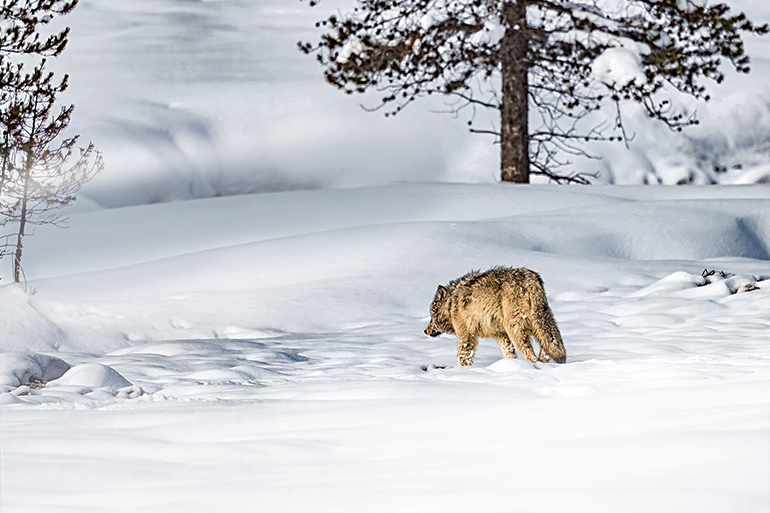
Looking at coyote hunting as just a winter diversion and something I could take on with minimal planning has faded away over the past two decades. That reality hit home as I trudged through several miles of snow under a frigid canopy of stars trying to reach a far corner of public land before daybreak.
When I first started hunting predators back in the day, one could find success hiking several hundred yards from a busy county road and blowing a random tune of distress on a Burnham Brothers hand call. Like deer and elk hunting, the reliance of public land for hunting pursuits has also transformed the nature of coyotes. Add in the additional hunters pursuing predators with advanced accuracy in firearms and technically assisted calling and you soon realize you’re hunting coyotes that have an Oxford education. The days of coyotes running you over after the holidays to get to a call are as distant as your mullet hairdo.
Setting up on a high knob, I recalled the tracks at the trailhead indicating I was one of several who had already hiked into this parcel. Waiting for daylight allowed me to mull over my choice of calls. I soon settled on a simple howl followed by some crow chatter. Any surviving coyotes likely had heard every perishing sound of rodents found in the library of a digital caller. When I could see clearly through my optics, I touched off a lonesome howl to begin another attempt at a public-land coyote.
PRESSURED PREDATORS ON PUBLIC LANDS
North America has a plethora of public land for hunting. Most lands contain predators, with coyotes making up the bulk of the inhabitants. As coyotes continue their expansion, they occupy habitat on county, state, and federal lands, giving you backyard access to one of nature’s savviest adversaries. Simultaneous with the coyote expansion has been a slow closure of private lands to hunting as more and more landowners manage properties for exclusive wildlife hunting. That prompts more of us to public lands. Also occurring in this same sliver of time has been a major marketing push of predator hunting products. The hunting industry saw a hunger for new gear and delivered in the form of firearms, ammunition, camouflage, predator calls, and specialized gear like backpacks.
Do the math. More of us are bunching up on public lands and educating coyotes faster than ever. By the time the ball drops in Times Square, you must be craftier than a hedge fund manager to outwit an educated public-land coyote. You don’t have to attend MIT to craft a new strategy, but you must scrutinize and tweak your go-to tactics to make a late-season coyote slip up for a reticle rendezvous.
BACK TO BASICS
The super-computer makeup of many electronic predator callers has many of us pretending to be at NASA launch command when we dial up a calling sequence. That’s all good, and sometimes a bit of storytelling through sound has the potential to make a coyote bound in for a shot. It also can have the opposite effect.
Since most hunters utilize an electronic caller and have the itch to push buttons, consider a simpler message. A short burst of squeaking rodent or the brief bawl of a fawn may go further in piquing a coyote’s interest than minutes of wildlife opera. You can even use traditional sounds of rabbits or hares in distress, but keep the message subdued with brief blasts.
For an even greater break from trends, consider going back to the hand call. A simple hand call sounds different than battery-run sounds, may reach higher frequencies, and offers an inexpensive but effective method over a digital caller. I keep a stash of hand calls in my predator pack and use them with equal frequency to stand apart from the public-land crowd. On still mornings, my mainstay call is a rodent squeaker operated with the squeeze of my hand. It’s amazing how far that sound carries across a calm landscape and its effect on coyotes is mesmerizing.
EMBRACE YOUR INNER DEER HUNTER
More than nine million of you hunt big game, typically deer, every year, according to the latest U.S. Fish and Wildlife Service National Survey of Fishing, Hunting and Wildlife-Associated Recreation. That hunting insight and experience gives you a springboard to your next coyote.
Coyotes have to travel miles to find their next meal, and oftentimes they pattern to places where the hunting excels. Using vantage points, wind dominance, and past coyote encounters, you may be able to put yourself in a position to waylay a wandering coyote the whitetail way. You may be hunting coyotes on your deer property, which provides access to pre-set stands or blinds along major travel corridors. Use them along with information from previous coyote encounters.
In the case of hunting a new property, spend a few minutes quizzing the land manager on past coyote sightings. Note those on your hunting app, like HuntStand, and then use the imagery to scout virtually for possible stand sites along funnels and fence lines and near livestock where coyotes love to lounge. Coyotes also vary their home range depending on geographic location and hunting success. Data suggests coyotes in Texas may have only a two-mile-square home range whereas some Western coyotes may exceed a range of 20 square miles. Eastern coyotes often fall in between, but keep in mind that coyote density, prey abundance, and home range all affect your sightings and whether you should take a wait-and-see approach.
BECOME THE COYOTE
This tactic goes hand in hand with the earlier back-to-basics category, but because it requires that you learn an entirely new language, it needs to stand on its own. You feel more comfortable hearing your customary language, and when coyotes hear another coyote, it can have a similar effect.
You don’t need to learn phrases like “where is the restroom,” but you do need to understand a few simple sounds so that you attract and not repel coyotes. If you want to be a simpleton, you can simply use the lone howl. The sound of a single coyote noting its whereabouts without a threatening tone has many implications. It can lure in coyotes looking for company or a hunting partner. It can cause a territorial dominant coyote to seek you out for trouble. And February is mating season across much of coyote country, so any singles may trot in for a Tinder-like hookup. Most of the time, I lean toward a lone howl and leave it at that. It’s that good. Send several serenades across the landscape and sit back to spot the results.
As the coyote rut begins the leadup to February breeding, you can also use female vocalizations, like female whimpers or estrus whines. Many of these high-pitched yips and whines are found in the libraries of electronic callers. They advertise willingness to males within earshot that a female may be ready for connubial bliss.

Another sound found on many callers is the dominant challenge howl. This aggressive howl with some added barks can cause a bossy coyote to roll in for a brawl, but it may also scare subordinate or young coyotes away. Too much barking signifies danger, so be reserved.
EMPLOY TECHNOLOGY & INNOVATION
One of the benefits of modern callers—beyond the incredible library of sounds—is the ability to run the unit remotely. You can place it 100 yards away (or farther) to lure a coyote into the shooting lane of your choice and completely remove prying eyes on you. All attention will be on the location of the sound, giving you opportunity to adjust and shoot as all eyes are looking away.
Keep in mind that many units require line of sight for the remote and the unit to operate, so read the instructions to see if this is the case. Those that don’t have this restriction give you more freedom to hide the caller in a field depression or behind a deadfall to further make a coyote search out the origins of the sound as you flip off the safety. Test the unit to confirm its communication range.
To get the most out of this extra offering, use your hunting app or onsite experience to map out an upwind location for the speaker. Placing the speaker upwind from you at a distance gives the coyote plenty of room to circle between you and the sound and prompts the coyote to stay upwind of you as it studies the sound location. A distance of 100 to 200 yards away from the sound is ideal for a coyote to circle in most instances.
Finally, as you walk out to place the caller, be aware of your form and stay out of sight as much as possible, especially in open country. Remember to spray down your footwear with a quality scent-eliminating product, such as Wildlife Research Center Scent Killer. Coyotes have olfactory senses that are superior to most animals, and one whiff of you is a game-ender.
OUTSMART THE BIPEDAL COMPONENT
A final way to win with pressured, public-land coyotes requires you to simultaneously outwit the bipedal competition. You can adopt tactics we’ve suggested, but you can’t alter the hunting pressure of fellow fur-takers. Instead, study their ritualistic habits and leave the lemming world behind.
Several studies have recorded how far hunters walk from a trailhead or public parking area. Most stop before they reach a mile. Make it a goal to go beyond that marker. By midwinter, most coyotes realize that the road represents risk and sounds near that hubbub signify danger. By daylight, many coyotes have left the danger zones in the rearview mirror for safer digs in remote sections of public parcels. If you push farther to reach those locations, you could find a more responsive coyote.
To get to those locations, I utilize nontraditional jump-off points. Bypassing public parking areas, I look for places where the public land converges with access roads or trails. Roadside pullouts are fine for admittance. Links that provide speedy access to out-of-the-way corners of public lands receive the greatest attention. Those that neighbor managed expanses of private land with 200-yard shooting windows on the public side rank even higher. A proven hunting app with property boundaries, distance measuring tools, and high-definition images keeps you on track and legal if you run across an argumentative deed holder.
My morning vantage point provided me with a nearly unlimited shooting range as daylight broke. My coyote dog Sage sat by my side as I used a diaphragm call to send a series of lone howls across the dimly lit landscape. Nothing answered back, as is the norm, but I kept a keen eye out as coyotes often show up without warning. After about 10 minutes I introduced a chorus of crow caws in hope of fooling a coyote into thinking that not only was a coyote nearby, but also it, along with the crows, was enjoying carcass leftovers.
The sun was breaking when I suddenly spotted the peering eyes of a coyote through the distant sagebrush. Sage growled, but I whispered, “Stay,” as I could see by its attitude that the coyote was already edgy and suspicious. When it started to circle wide and vanished into the sagebrush, I readjusted for the next opening. The coyote reappeared and sat to stare, but this time I was settling my reticle for the 300-yard shot and ended the education of this public-land coyote with a 2,300 fps wakeup call.








